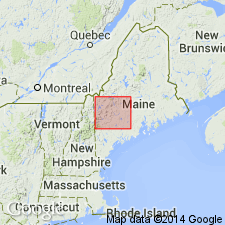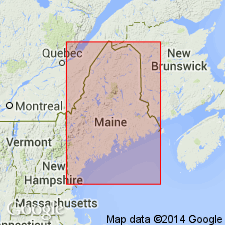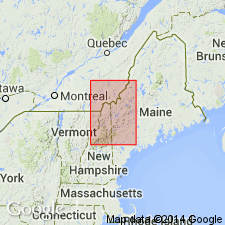
- Usage in publication:
-
- Patch Mountain Member*
- Modifications:
-
- Revised
- Overview
- AAPG geologic province:
-
- New England province
Summary:
Mapped as a Member of Sangerville Formation after usage of Pankiwskyj (1979). Type Patch Mountain is exposed in core of broad antiform and cannot be mapped directly into northeast-trending belts of calcareous rocks that are parallel to southeast side of map area. These calcareous rocks correlate with each other and with type Patch Mountain on the basis of lithologic similarity and structural reconstruction. Wedges out within body of Sangerville to the northwest across strike.
Source: GNU records (USGS DDS-6; Reston GNULEX).

- Usage in publication:
-
- Patch Mountain Member
- Modifications:
-
- Revised
- AAPG geologic province:
-
- New England province
Summary:
Sangerville Formation in the Buckfield area is divided into (ascending): Moody Brook, Berry Ledge, Noyes Mountain, Patch Mountain, and Turner members. Replaces Buckfield Group in report area and overlies Anasagunticook Member of Waterville Formation. [Intent to revise the above units is not stated, but subdivision of the Sangerville and its lower contact are clearly shown in a stratigraphic column.] Order of younging within the Sangerville differs from reports of previous workers. Graded sequences suggest an inverted lithologic package. Rocks in this area were subjected to three deformational events.
Source: GNU records (USGS DDS-6; Reston GNULEX).

- Usage in publication:
-
- Patch Mountain Limestone Member*
- Modifications:
-
- Age modified
- Revised
- AAPG geologic province:
-
- New England province
Summary:
Patch Mountain Member of Sangerville Formation is here revised as Patch Mountain Limestone Member to emphasize the calcareous composition of the unit. At high metamorphic grade in the Bryant Pond and Buckfield 15-min quads, ME, consists of thinly interbedded impure marble, coarsely crystallized calc-silicate rocks, biotite-quartz-plagioclase granofels, and minor pelitic schist. At lower metamorphic grade to the east, consists of thinly interbedded gray, micritic metalimestone, limy metasandstone, metasiltstone, and slate or pelitic schist. Age of Sangerville is modified to Silurian (Wenlockian) following Osberg (1988).
Source: GNU records (USGS DDS-6; Reston GNULEX).
For more information, please contact Nancy Stamm, Geologic Names Committee Secretary.
Asterisk (*) indicates published by U.S. Geological Survey authors.
"No current usage" (†) implies that a name has been abandoned or has fallen into disuse. Former usage and, if known, replacement name given in parentheses ( ).
Slash (/) indicates name conflicts with nomenclatural guidelines (CSN, 1933; ACSN, 1961, 1970; NACSN, 1983, 2005, 2021). May be explained within brackets ([ ]).

